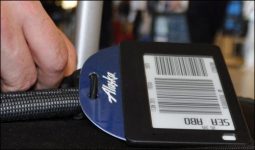
Alaska Airlines adopts RFID electronic luggage tags
[ad_1]
Alaska Airlines provides high-tech baggage tags for 500 frequent passengers to speed up boarding procedures. The airline is using ViewTag provided by Vanguard ID Systems, equipped with an electronic paper screen, BLE and passive EPC Gen2 UHF RFID embedded. In November 2016, the airline plans to evaluate the results of the use, and then decide whether to continue to promote ViewTag.
ViewTag has been used in the market for more than 10 years. Airlines are using these tags to replace traditional QR codes and paper luggage tags to identify and track passenger luggage. ViewTag is a smart, electronic, reusable luggage tag designed to reduce passenger queues and better locate luggage. In its initial version, ViewTag uses NFC and UHF RFID technology and is equipped with an electronic paper screen to display the three-letter code of the passenger’s destination airport. The version used by Alaska Airlines is equipped with a larger electronic paper screen for BLE for communicating with smart phones. In this way, passengers can update flight information (flight number, destination, etc.) using the Bluetooth technology built into the mobile phone.

(Vanguard ID Systems’ ViewTag has a built-in passive UHF embedded, which can be used to track and identify luggage; the tag is also equipped with an electronic paper screen to display the passenger’s flight number and terminal in the form of text and QR codes)
The latest version of ViewTag is also equipped with NFC function, which can be used to update flight information on the electronic paper screen.
In the past few years, Vanguard ID has been cooperating with Alaska Airlines’ CX laboratory (customer research and development team) to reduce some of the troubles in air travel. The team was established in 2013, and a project of the team has shortened the waiting time. The team also tested fingerprint boarding passes and ID cards. Currently, the team is working on a better way to track the movement of luggage.
Last summer, the airline tried ViewTag and distributed tags to 50 employees and 50 passengers. Alaska Airlines customer research and development manager Loesje DeGroen said: “So far, employees and passengers are satisfied with the label. Therefore, this summer, we will expand the test range to 500 passengers.”
The airline also provides a check-in application, which 500 frequent customers who use ViewTag can use to check their luggage. The size of the tag is 3 inches * 2 inches, and it is attached to the luggage through a nylon rope bag. Since the tag is equipped with a Bluetooth module, the tag can communicate with smart phones (3-5 years of battery life).
First, passengers log in on the mobile app and follow the prompts to check in. This action can be done anytime, anywhere. When passengers want to register their luggage, they can use the app to display the flight number and terminal information on the electronic screen. In this way, users can show information to the check-in counter and no longer need to print traditional paper luggage tags.
ViewTag has a built-in Impinj Monza 5 RFID chip, and the company will use other RFID hardware in the future.
Airline staff can also use the tag UHF RFIDThe function quickly recognizes tags and sends luggage location information to customers. If an RFID reader is installed above the luggage conveyor belt, each luggage tag can be read. In this way, passengers can know more detailed location information.
In addition, if the luggage fails to arrive at the destination airport as expected, the passenger can receive the message and enter the receiving address as prompted. In this way, passengers do not need to wait in the baggage receiving area and report this information.
However, Alaska Airlines currently does not provide this feature. They only used ViewTag’s registration procedure speed-up function.
(Exclusive manuscript of rfid world network, please indicate the source author for reprinting!)
[ad_2]





